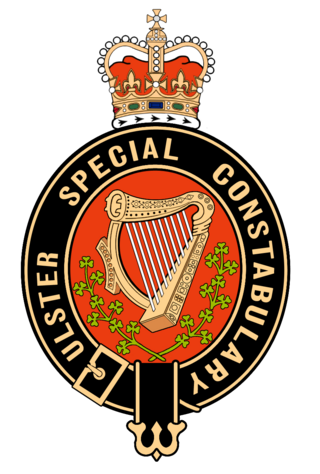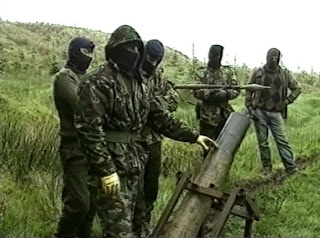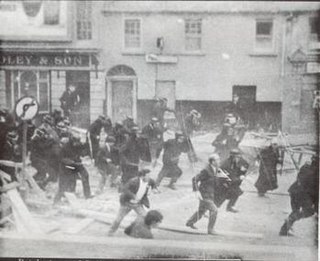Contents
| |||||
| Centuries: | |||||
|---|---|---|---|---|---|
| Decades: | |||||
| See also: | |||||
Events during the year 1956 in Northern Ireland.
| |||||
| Centuries: | |||||
|---|---|---|---|---|---|
| Decades: | |||||
| See also: | |||||
Events during the year 1956 in Northern Ireland.

The Royal Ulster Constabulary (RUC) was the police force in Northern Ireland from 1922 to 2001. It was founded on 1 June 1922 as a successor to the Royal Irish Constabulary (RIC) following the partition of Ireland. At its peak the force had around 8,500 officers, with a further 4,500 who were members of the RUC Reserve.

The Ulster Special Constabulary was a quasi-military reserve special constable police force in what would later become Northern Ireland. It was set up in October 1920, shortly before the partition of Ireland. The USC was an armed corps, organised partially on military lines and called out in times of emergency, such as war or insurgency. It performed this role most notably in the early 1920s during the Irish War of Independence and the 1956–1962 IRA Border Campaign.

The East Tyrone Brigade of the Provisional Irish Republican Army (IRA), also known as the Tyrone/Monaghan Brigade was one of the most active republican paramilitary groups in Northern Ireland during "the Troubles". It is believed to have drawn its membership from across the eastern side of County Tyrone as well as north County Monaghan and south County Londonderry.
The Border campaign was a guerrilla warfare campaign carried out by the Irish Republican Army (IRA) against targets in Northern Ireland, with the aim of overthrowing British rule there and creating a united Ireland. It was also referred to as the "resistance campaign" by some Irish republican activists. The campaign was a military failure, but for some of its members was justified as it kept the IRA engaged for another generation.
This is a chronology of activities by the Provisional Irish Republican Army (IRA) from 1970 to 1979.

The South Armagh Brigade of the Provisional Irish Republican Army (IRA) operated during the Troubles in south County Armagh. It was organised into two battalions, one around Jonesborough and another around Crossmaglen. By the 1990s, the South Armagh Brigade was thought to consist of about 40 members, roughly half of them living south of the border. It has allegedly been commanded since the 1970s by Thomas 'Slab' Murphy who is also alleged to be a member of the IRA's Army Council. Compared to other brigades, the South Armagh IRA was seen as an 'independent republic' within the republican movement, retaining a battalion organizational structure and not adopting the cell structure the rest of the IRA was forced to adopt after repeated intelligence failures.

From 1969 until 1997, the Provisional Irish Republican Army (IRA) conducted an armed paramilitary campaign primarily in Northern Ireland and England, aimed at ending British rule in Northern Ireland in order to create a united Ireland.

Ronnie Bunting was a Protestant Irish republican and socialist activist in Ireland. He became a member of the Official IRA in the early 1970s and was a founder-member of the Irish National Liberation Army (INLA) in 1974. He became leader of the INLA in 1978 and was assassinated in 1980 aged 32.
The Northern campaign was a series of attacks by the Irish Republican Army (IRA) Northern Command between September 1942 and December 1944 against the security forces in Northern Ireland. The action taken by the Northern Irish and the Irish governments as a result of these attacks shattered the IRA and resulted in the former being free from IRA activity by the end of World War II. In December 1956 the IRA began its Border Campaign which lasted until February 1962.
The Troubles in Keady refers to incidents taking place in Keady, County Armagh, Northern Ireland during the Troubles.
The Troubles in Bessbrook recounts incidents during and the effects of the Troubles in Bessbrook, County Armagh, Northern Ireland.

During 12–16 August 1969, there was an outbreak of political and sectarian violence throughout Northern Ireland, which is often seen as the beginning of the thirty-year conflict known as the Troubles. There had been sporadic violence throughout the year arising out of the Northern Ireland civil rights campaign, which demanded an end to discrimination against Catholics and Irish nationalists. Civil rights marches had been attacked by Protestant loyalists, and protesters often clashed with the Royal Ulster Constabulary (RUC), the overwhelmingly Protestant police force.
The South Armagh Republican Action Force(SARAF) shortened simply to the Republican Action Force(RAF) for a small number of attacks in Belfast was an Irish republican paramilitary group that was active from September 1975 to April 1977 during the Troubles in Northern Ireland. Its area of activity was mainly the southern part of County Armagh. According to writers such as Ed Moloney and Richard English, it was a cover name used by some members of the Provisional IRA South Armagh Brigade. The journalist Jack Holland, alleged that members of the Irish National Liberation Army (INLA) were also involved in the group. During the same time that the South Armagh Republican Action Force was active the INLA carried out at least one sectarian attack that killed Protestant civilians using the covername "Armagh People's Republican Army". According to Malcolm Sutton's database at CAIN, the South Armagh Republican Action Force was responsible for 24 deaths during the conflict, all of whom were classified as civilians.
Events during the year 1957 in Northern Ireland.
This is a chronology of activities by the Provisional Irish Republican Army (IRA) from 1980 to 1989. For actions before and after this period see Chronology of Provisional Irish Republican Army actions.

The Tullyvallen massacre took place on 1 September 1975, when Irish republican gunmen attacked an Orange Order meeting hall at Tullyvallen, near Newtownhamilton in County Armagh, Northern Ireland. The Orange Order is an Ulster Protestant and unionist brotherhood. Five Orangemen were killed and seven wounded in the shooting. The "South Armagh Republican Action Force" claimed responsibility, saying it was retaliation for a string of attacks on Catholic civilians by Loyalists. It is believed members of the Provisional IRA carried out the attack, despite the organisation being on ceasefire.

From 6 to 11 July 1997 there were mass protests, fierce riots and gun battles in Irish nationalist districts of Northern Ireland. Irish nationalists/republicans, in some cases supported by the Provisional Irish Republican Army (IRA), attacked the Royal Ulster Constabulary (RUC) and British Army. The protests and violence were sparked by the decision to allow the Orange Order to march through a Catholic/nationalist neighbourhood of Portadown. Irish nationalists were outraged by the decision and by the RUC's aggressive treatment of those protesting against the march. There had been a bitter dispute over the march for many years.
On 11 August 1970, two Royal Ulster Constabulary (RUC) officers were killed by a booby-trap bomb planted under a car by the Provisional Irish Republican Army (IRA) near Crossmaglen, in County Armagh, Northern Ireland. They were the first RUC officers to be killed by republicans during the Troubles and the first security forces to be killed in South Armagh, an IRA stronghold for much of the conflict.

Throughout the protracted conflict in Northern Ireland (1960s-1998), the Provisional IRA developed a series of improvised mortars to attack British Army and Royal Ulster Constabulary (RUC) security bases. The organisation also purchased both light and heavy machine guns in order to hamper the British Army supply of border bases by helicopter. The IRA fitted vehicles, specially vans and trucks, with both types of weapons. Vans, trucks and tractors were modified to transport concealed improvised mortars to a launch area near the intended target and fire them, while light and heavy trucks were employed as firing platforms mounting machine guns, particularly M60s and DShKs. Improvised armoured vehicles and heavy equipment were also used to penetrate the perimeter of fortified security bases. The IRA vehicles were often disguised as belonging to civilian companies or even government agencies.

The 1990 Lough Neagh ambush was a gun attack carried out by the Provisional IRA on 10 November 1990 at Castor Bay, near Morrows Point, Lough Neagh, County Armagh, Northern Ireland targeting members of the security forces involved in a waterfowl hunting trip with other two men at the time. An active service unit of the IRA's North Armagh Brigade shot dead a Royal Ulster Constabulary (RUC) Inspector, an RUC Reservist, a former Ulster Defence Regiment (UDR) soldier and one civilian. Some members of the wildfowling party struggled with their attackers, and one of the constables returned fire before being killed.